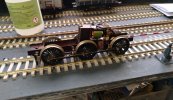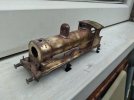Dave
Western Thunderer
I have been rebuilding the second hand unfinished project L&Y Class 27.
This is how it looked when I acquired it.


The chassis was in a poor state. The soldering wasn't as good as that on the bodywork, which makes me wonder if this is the abandoned project of more than one previous owner.

The motor didn't work, but I would have binned it in any case. Running a 30:1 gearset, it would have gone like a rocket! The wheels were terrible old things, too. It had been regauged to EM by fitting extended axles and lots of fibre washers. The brake gear was a mess, the hangers and blocks were fitted facing inward and the tags from the frets hadn't even been filed off before assembly.
I stripped the paint from the body and also chopped off the handrails and pillars, which were all oversize. The vac brake pipes were horrible things, made from brass wire and springs. They have gone in the bin and will be replaced with something nicer.

I rebuilt the chassis using Gibson wheels and a High Level gearbox and coreless motor. It needs the rods to be permanently fitted and the brake gear adding.

I have stripped the paint from the tender, so that the coal rails can be fitted as these were still in the box and the prototype I intend to model (BR 52244) had coal rails . That's the next job.
I will be fitting DCC sound and a Stay Alive. I want to try and get it all in the loco itself and not have wires running to and fro the tender.
This is how it looked when I acquired it.


The chassis was in a poor state. The soldering wasn't as good as that on the bodywork, which makes me wonder if this is the abandoned project of more than one previous owner.

The motor didn't work, but I would have binned it in any case. Running a 30:1 gearset, it would have gone like a rocket! The wheels were terrible old things, too. It had been regauged to EM by fitting extended axles and lots of fibre washers. The brake gear was a mess, the hangers and blocks were fitted facing inward and the tags from the frets hadn't even been filed off before assembly.
I stripped the paint from the body and also chopped off the handrails and pillars, which were all oversize. The vac brake pipes were horrible things, made from brass wire and springs. They have gone in the bin and will be replaced with something nicer.

I rebuilt the chassis using Gibson wheels and a High Level gearbox and coreless motor. It needs the rods to be permanently fitted and the brake gear adding.

I have stripped the paint from the tender, so that the coal rails can be fitted as these were still in the box and the prototype I intend to model (BR 52244) had coal rails . That's the next job.
I will be fitting DCC sound and a Stay Alive. I want to try and get it all in the loco itself and not have wires running to and fro the tender.

































